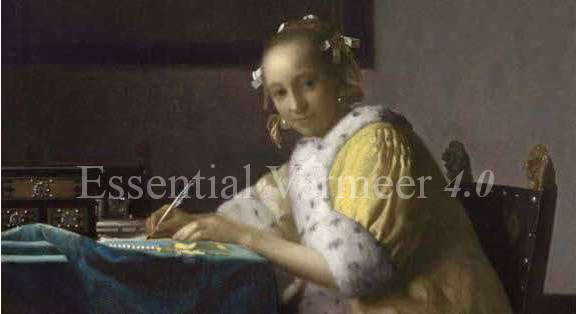The Badger Brush

Woman in Blue Reading a Letter
Johannes Vermeer
c. 1662–1665
Oil on canvas, 46.5 x 39 cm.
Rijksmuseum, Amsterdam
Vermeer's technical evolution can be roughly divided into three periods. His first works are characterized by evident brushwork and rich impasto application of paint. The Italian term "impasto," refers to a thick, light-toned opaque layer of paint that leaves observable brushstrokes. Passages painted with impasto acquire a sense of vigor and forcefulness not achievable with flat layers of paint.
In the works of Vermeer's middle period, such as the Woman in Blue Reading a Letter, pictorial substance is hidden as much as possible so as to not destroy delicate chiaroscural transitions which define form and volume via optical, rather than tactile description. The face of the young woman in the Woman in Blue provides perfect a example of the suffused contours and refined modeling which are characteristic of works of this period. In order to obtain such delicate transitions, Vermeer may have used a so-called badger brush, a type of artist's brush that uses the hair of a badger as the bristles. Badger hair is particularly valued for its softness, yet it has a certain stiffness to it, which is not as pronounced as hog bristle but offers more resistance than sable hair. This unique combination of characteristics makes it ideal for certain painting techniques, especially in oil painting.
The badger brush was standard equipment in the seventeenth-century workshop. In the eighteenth and ninteenth centuries it was widely used by the portrait painter and were known by terms such as "sweeteners" or "softeners. In the twentieth century, the use of the badger brush has greatly diminished among artists as painters, who began to favor "painterly" styles, no longer found smoothness a desirable aesthetic quality.
The badger brush was used principally for two purposes. One, adjacent areas of wet paint could be delicately blended creating impalpable transitions unattainable with typical rounded brushes. Two, glazes, or transparent layers of paint, could be applied uniformly over a monochrome underpainting without leaving even the slightest trace of the brush.
Originally, badger brushes were made from badger hair, which is softer than hog hair but not as flexible as sable. Badger hair, which can be sourced from various parts of the world, is more readily available than most animal hair, though the quality can vary significantly. Badger hair is thickest at the point, and relatively thin at the root, so it has a distinctive "bushy" appearance. Badger hairs are arranged in the metal ferrule of the brush to create a flat fan-like form.
Interestingly, the badger brush is not typically used to apply paint. Two different shades of paint are roughly applied to the canvas with a normal brush. While the paint is still wet, the badger brush is delicately maneuvered over two tones with a light, sweeping back and forth motion, thereby blending and removing all traces of paint relief. Due to its feather-like thinness, the badger brush does not really move appreciable quantities of paint. Once the brush has picked up too much paint on its tip, it must be cleaned with a solvent and thoroughly dried before it can be used again.
The badger brush may also used to spread out thin transparent layers of paint, called glazes, which are applied of over a dry, monochromatic underpainting. Glaze paint typically includes inherently transparent pigment combined with a viscous medium like Stand Oil or Venetian turpentine, and a touch of gum turpentine to enhance fluidity. This superimposed glaze serves solely as a coloring agent, similar to a thin sheet of transparent colored acetate placed over a monochrome photograph.





 or anything else that isn't working as it should be, I'd love to hear it! Please write me at:
or anything else that isn't working as it should be, I'd love to hear it! Please write me at: